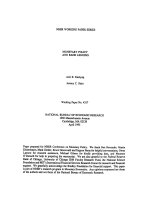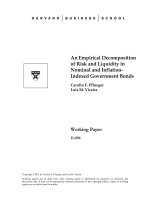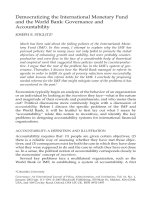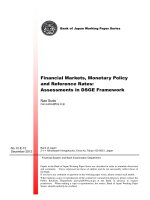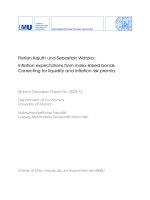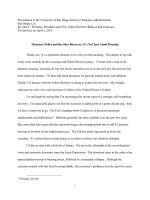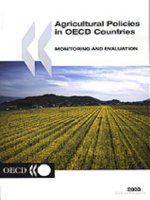bemholz - monetary regimes and inflation (2003)
Bạn đang xem bản rút gọn của tài liệu. Xem và tải ngay bản đầy đủ của tài liệu tại đây (5.49 MB, 225 trang )
Monetary Regimes
and
InflationMonetary Regimes
and Inflation
History, Economic and Political Relationships
Peter Bemholz
Professor Emeritus
of
Economics, Centre
for
Economics
and
Business (WWZ) University
of
Bas
Ie,
Switzerland
Edward
Elgar
Cheltenham, UK • Northampton, MA, USA
© Peter Bernholz 2003
All rights reserved. No part
of
this publication may be reproduced, stored
in
a retrieval system
or
transmitted in any form
or
by any means, electronic,
mechanical
or
photocopying, recording,
or
otherwise without the prior
permission
of
the publisher.
Published by
Edward Elgar Publishing Limited
The Lypiatts
15
Lansdown Road
Cheltenham
Glos GL50 2JA
UK
Edward Elgar Publishing, Inc.
William Pratt House
9 Dewey Court
Northampton
Massachusetts 01060
USA
This book has been printed on demand to keep the title in print.
A catalogue record for this book
is available from the British Library
Library
of Congress Cataloguing in Publication Data
Bernholz, Peter.
Monetary regimes and inflation: history, economic and political relationshipsiby
Peter Bernholz.
p.cm.
1. Inflation (Finance)- History. 2. Monetary policy- History. 3. Economic
stabilization.
I.
Title.
HG229.B4852003
332.4'
l-dc21
ISBN 978 1 84376 155 6 (cased)
978 1 84542 778 8 (paperback)
2002034659
Contents
Preface IX
Acknowledgements
xi
1 Introduction 1
2 Inflation and monetary regimes 3
2.1
Inflations: long-term historical evidence 3
2.2 A description
of
different monetary regimes 5
2.3 Monetary regimes and inflation 7
2.4
The inflationary bias
of
political systems
11
2.5 The influence
of
monetary regimes
14
2.6 Some other characteristics
of
monetary constitutions
15
2.7
Conclusions
18
3
Inflation under metallic monetary regimes
21
3.1
Inflation caused by an additional supply
of
the monetary
metal
21
3.2 The debasement
of
metal standards by rulers
24
3.3
Reasons for the introduction and maintenance
of
stable
metallic monetary regimes
30
3.4
Price and exchange controls 32
3.5
Consequences
of
inflation for the real economy 34
3.6
Conclusions 36
4 Moderate paper money inflations 40
4.1
The introduction
of
paper money 40
4.2
Paper money inflation in Sweden during the 18th century
41
4.3
Paper money inflation in Massachusetts, 1703-1749 45
4.4
Inflation during the American War
of
Independence 47
4.5
Paper money inflation during the American Civil War 50
4.6 Chinese paper money inflation under the Ming regime
52
4.7
Conclusions
61
5
Characteristics
of
hyperinflations
64
Introduction
64
5.1
Some characteristics
of
the French hyperinflation
66
v
VI
Contents
5.2
Hyperinflations are caused by government budget deficits
69
5.3
Real stock
of
money and currency substitution
74
5.4
Undervaluation and currency substitution
82
5.5
*Undervaluation as a consequence
of
currency substitution:
a simple model
90
5.6
Other characteristics
of
hyperinflations
92
5.6.1
Consequences
of
high inflation for capital markets
92
5.6.2
The development
of
prices
95
5.7
Economic activity and unemployment
101
5.8
The political economy
of
high inflation
104
5.9
Social and political consequences
of
hyperinflation
107
5.10
Conclusions
110
6
Currency
competition, inflation,
Gresham's
Law
and
exchange
rate
114
6.1
Introduction
114
6.2
Empirical evidence for periods one to three
116
6.3
*The model
118
6.4
*First period: introduction
of
paper money
121
6.5
*Second period: fixed exchange rate and loss
of
official
reserves
122
6.6
*Third period: Gresham's Law at work
123
6.7
*Fourth Period: The return
of
good money
126
6.8
Conclusions
131
7
Ending
mild
or
moderate
inflations
135
7.1
Conditions favouring the stabilisation
of
moderate inflation
135
7.2
Restoration
of
stable monetary constitutions after wars at the
old parity
136
7.3
Preconditions for returning
to
a stable monetary regime at a
new parity
138
7.4
Further discussion
of
historical examples
146
7.5
More recent historical examples
151
7.6
Conclusions
157
8
Currency
reforms
ending
hyperinflations
160
8.1
Introduction
160
8.2
Political-economic preconditions for initiating successful
reforms
162
8.3
Sufficient economic and institutional conditions for
successful currency reforms
163
Contents
Vll
8.4 Characteristics
of
most successful currency reforms:
empirical evidence 166
8.5 Less and least successful reforms
175
8.6 The influence
of
wrong evaluations
of
reform packages by
the public 189
8.7 Conclusions
193
Appendix Sources for historical data not identified in the text and
literature relating to different cases
of
hyperinflation 197
Index 207
Many good books and a huge number
of
articles have been written on infla-
tion. As a consequence, a new book on this subject can only be justified
by
looking at events from a different perspective. This has been done in several
respects.
First, a comparative historical analysis going back to the Roman
currency debasement in the fourth century and ending with the hyperinflations
(that is high inflations with a monthly rate
of
50
per
cent or more during at
least one month)
of
the 1990s has been used. Second, all 29 hyperinflations in
history (which all occurred, with the exception
of
the hyperinflation
of
the
French Revolution, in the 20th century) and the currency reforms ending them
have been included in the analysis.
Third, the political forces responsible for
inflation and for ending it by adequate reforms are discussed, together with the
conditions under which they can be expected to operate. Fourth, the impor-
tance
of
monetary regimes for the stability
of
money
is
documented. Fifth, it
is shown that certain qualitative characteristics
of
inflations and
of
their conse-
quences are stable traits over centuries. Finally, a clear distinction has been
made between the differing traits
of
moderate and high inflations and the
reforms necessary to end them.
Chapter 1 offers a very
brief
historical overview. In Chapter 2 the impor-
tance
of
monetary regimes for monetary stability, given the inflationary bias
of
political systems, is documented and discussed. Chapter 3 analyses inflation
if
commodity standards in the form
of
metallic monetary regimes are present.
In Chapter 4 moderate paper money inflations are studied, whereas in Chapter
5 all historical hyperinflations are extensively analysed. Chapter 6 provides a
formal analytical framework for a complete inflationary cycle from the intro-
duction
of
paper money to its total substitution
by
stable metallic money or
foreign currencies. In Chapters 7 and 8 the political and economic conditions
for successfully terminating moderate and high inflations respectively are
described with the help
of
comparative historical analyses.
In writing the book formal mathematical analysis has been kept to a mini-
mum.
Still, some exceptions have been made for a deeper understanding. They
can however be left out
by
the reader without losing the general thread
of
the
argument, and have been noted with an asterisk
*.
To
enliven the reading
of
the book, short personal experiences
of
contemporary observers have been
inserted into the
text, especially in Chapter
5.
They are observations by people
like Ernest Hemingway and Stefan
Zweig, who did not have any knowledge
ix
x
Preface
of
the economics
of
inflation. As a consequence, the evidence provided by
them is often more convincing than any econometric analysis would be.
The literature on inflations is
huge, so that only a part directly relevant to
our argument will be quoted in the references. But to allow the reader to delve
lTIOre
deeply into the discussion concerning the different experiences with
hyperinflation, some additional works will be mentioned
in
the Appendix
together with the sources
of
the data presented.
I would like to express my gratitude to Pieter Emmer, Leiden, Hans
Gersbach, Heidelberg, and an anonymous referee for reading all or part
of
the
manuscript and for providing important advice on how to improve it. I am also
grateful to the Wissenschaftskolleg (Centre for Advanced Studies) zu Berlin,
where I stayed as a Fellow for the academic year 2000/01, and was able to
draw upon the generous support
of
the library staff when working on the
manuscript. Above all, I would like to thank my wife, Elisabeth Bernholz
Homann, for her patience with a husband embroiled for long months in writ-
ing this book.
Acknowledgements
The author and publishers wish to thank the following who have kindly given
permission for the use
of
copyright material in Chapters
2,
4 section
6,
5
section 3, and
6.
Bernholz, Peter (1983), 'Inflation and Monetary Constitutions in Historical
Perspective',
Kyklos, 36, 397-419.
Bemholz, Peter (1989), 'Currency Competition, Inflation, Gresham's Law and
Exchange Rate',
Journal
of
Institutional
and
Theoretical Economics,
145
(3), 465-88.
Bemholz, Peter (1997),
'Paper
Money Inflation,
Gresham's
Law and
Exchange Rates in Ming China',
Kredit und Kapital,
30(1),
35-51.
Bemholz, Peter (2001), 'Monetary Constitution, Political-Economic Regime,
and Long-Term Inflation',
Constitutional Political Economy,
12,3-12.
Every effort has been made to trace the copyright holders but
if
any have been
inadvertently overlooked the publishers will be pleased to make the necessary
arrangements at the first opportunity.
xi
Introduction
Inflation presupposes the existence
of
money, which evolved as an unplanned
social institution by a number
of
inventions and innovations during a period
of
perhaps 2500 years. It was fully developed with the introduction
of
coins in
Lydia and Ionia about 630 BC, and in China at about the same time.
It follows that inflation cannot be older than money. But it seems that espe-
cially rulers soon detected the potential to increase their revenues by tamper-
ing with its value. Already in antiquity we know
of
many cases
of
lowering the
intrinsic metallic value
of
coins for this purpose. Examples are the minting
of
bad coins by Athens during the Peloponnesian War (Aristophanes,
The
Frogs,
719-37) or by Rome during the Second Punic War, especially from 217 BC
(Heichelheim 1955,
p.
503).
The damage and suffering caused by inflation during the course
of
history
are enormous. Still, the worst excesses
of
inflation occurred only in the 20th
century. This development was a consequence
of
the further technical devel-
opment
of
money from coins to paper money and book money together with
changes in the monetary regime or constitution ruling supply and control
of
money.
The use
of
the word inflation for an expansion
of
the money supply or an
increase
in
prices, quite in contrast to the first occurrences
of
inflation as
historical events,
is
of
rather recent origin. The term derives from the Latin
inflare (to blow
up
or inflate) and was first used in 1838 in the context
of
an
inflation
of
the currency, according to the Oxford English Dictionary (1989).
During the following years until 1874 it was also employed for an
inflation
of
credit and an inflation
of
prices. This meaning
of
the word seems to have been
strengthened during the American Civil War (1861-65), when the gold dollar
was supplanted by the
greenback, a paper money issued by the Government,
which soon lost part
of
its value.
We
will use the term 'inflation' only for an increase
of
the price level
extending over a longer period, usually several years, as measured by one or
several price indices. It follows that we do not consider the increase
of
the
prices
of
a small group
of
goods like that
of
oil and its derivatives or
of
food
caused by a bad harvest as inflation. In an inflation all or at least most prices
rise according to this definition.
History has seen inflations
of
very different magnitudes, ranging from the
1
2
Monetary regimes
and
inflation
so-called price revolution
of
the 16th century, which was caused
by
the inflow
of
gold and especially silver looted and mined by the Spaniards in Latin
America, to the biggest paper money inflation
of
all times
in
Hungary after
World War
2.
Whereas the former implied only an average annual increase
of
the price level by about two per cent over a period
of
nearly one hundred
years, the latter led in a limited period
of
six years up to rates
of
inflation
of
about 350 per cent per day in the summer
of
1946. Because
of
these different
orders
of
magnitude it has become customary to speak
of
creeping or mild
inflation,
of
galloping and accelerating inflation, and
of
high and hyperinfla-
tion,
though mostly no clear delimitation
of
these terms has been offered. An
exception is the definition
of
hyperinflation introduced by the American econ-
omist Philip Cagan (1956), which
is
present
in
all cases
in
which monthly
inflation has reached
in
at least one month 50 per cent or more. It is convenient
to adopt this somewhat arbitrary convention, which is arbitrary since many
other
high inflations show the same qualitative characteristics, as we will see.
In this book, therefore,
hyperinflations will be seen as extreme cases
of
high
inflations.
We
will also employ the term moderate inflation. The borderline
between this type
of
inflation and high inflations will be defined with the help
of
the real stock
of
money, as given by the stock
of
money divided by the price
level and corrected by the growth
of
Gross Domestic Product, GOP. Whenever
this corrected real stock
of
money declines during an inflationary process, high
inflation
begins according to our definition. It
is
true that this definition does
not provide a clear dividing line in terms
of
a percentage inflation. But it has
the advantage that it points our attention to the time from which the public tries
to escape the loss
of
value
of
their money by reducing its use by a flight into
other currencies or commodities.
The following chapters
of
this book will turn first to the description
of
empirical historical facts concerning inflations.
In
doing so we will especially
analyse the qualitative characteristics
of
high inflations. By looking at these
facts it will be relatively easy to explain political and economic causes ofinfla-
tion, and to present a macroeconomic model
of
the latter relationships. A study
of
how inflations can be successfully ended concludes the book.
REFERENCES
Cagan, Philip (1956),
'The
Monetary Dynamics
of
Hyperinflation', in Milton
Friedman (ed.),
Studies
in
the Quantity Theory
of
Money, Chicago: University
of
Chicago Press.
Heichelheim, Fritz
W.
(1955),
'On
Ancient Price Trends from the Early First
Millennium BC to Heraclius
I',
Finanzarchiv, 15(3),
498-511.
2.
Inflation and monetary regimes
l
2.1
INFLATIONS: LONG-TERM HISTORICAL EVIDENCE
We
turn first
to
the long-tenn development
of
inflation since about 1800
in
several countries belonging for decades
to
the most highly developed economies
of
the world (Figure 2.1). On the vertical axis the logarithm
of
the cost
of
living
index, CPI,
is
depicted, whereas time
is
denoted on the horizontal axis.
We
have
used the logarithm
of
CPI since CPI itselfwould not fit on the page.
As we can see from the figure, the price levels
of
the United States, Great
Britain, France and Switzerland do not show an upward or downward trend
1790
= 2
4.8
-r ~___,
4.3
C'3.8
~
u
:53.3
2.8
2.3
1750 1810 1830 1850 1870 1890 1910 1930 1950 1970 1990
1790/92 1913/14 1998
Year
-0-
GB
-0-
France
l:r-
Switzerland
-0-
USA
Sources: Mitchell (1976), pp. 735-47. Statistisches Bundesamt (1981), pp.
704-6.
US Bureau
of
the Census (1976), Historical Statistics
of
the United States: Colonial Times
to
1970.
Bicentennial Edition. Statistisches Bundesamt (2000), pp. 230f.
Figure
2.1
Development
of
cost
of
living indices in
four
countries
(logarithms)
3
4
Monetary regimes
and
inflation
2600
., ~
2100
o
o
1600
II
o
lr)
0\
1100
~
600
1950 1960 1965 1970 1975 1980 1985 1990 1995 2000
Year
~
GB
0-
(West) Germany -t:s:-France
~
Switzerland
-0-
Italy
-e-
USA
Sources: See Figure 2.1.
Figure 2.2 Development
of
cost
of
living indices
in
six countries,
1950-2000
before 1914, but only long-term swings. The situation changes, however, after
1914 and at least from 1930, since a pronounced upward trend, that is a long-
term inflation, can be observed after this time for all these countries, includ-
ing Switzerland.
The empirical evidence
just
presented leads to the question, how the differ-
ence in inflation performance before and after 1914/30 can be explained.
Before trying to answer this question it is however advisable to take a closer
look at the development
of
inflation in some developed countries from 1950
to 1998 (Figure 2.2). Note that in this case no logarithms
of
the cost
of
living
index have been used on the vertical axis.
The figure draws our attention to three facts:
1.
an inflationary development can be observed for the whole period;
2.
inflation has accelerated since about 1970;
3. after 1970 two groups
of
countries show different inflationary develop-
ments. The first group consisting
of
Italy, France and Great Britain shows
a higher rate
of
inflation than the second consisting
of
Switzerland, (West)
Germany and the United States.
Inflation
and
monetary regimes
5
In Section 2.3 we try to answer the question why these different paths
of
inflation could happen before and after 1914/30 and since 1950. Before doing
so, we have however to describe the main characteristics
of
different monetary
regimes.
2.2 A DESCRIPTION OF DIFFERENT MONETARY
REGIMES
Bya
monetary regime we understand the set
ofmles
governing the institutions
and organisations which finally determine the amount
of
money supplied.
If
we tum our attention to the laws and decrees containing all such formal rules
we speak
of
a monetary constitution. Subsequently we consider the following
monetary regimes:
1.
Metallic standards like the gold, silver or copper standard. In such
standards gold, silver or copper coins circulate, whose nominal face value
corresponds to the value
of
the metal contained in the respective coin. This
does not preclude token metallic coins also being used, whose metallic value
is
less than their nominal value. But such coins have been at least
in
modem
times convertible at their face value into the coins with full metal value.
If
banknotes exist they are also convertible at their face value into such coins.
The same
is
true for chequing accounts
of
the public held at the banks. The
gold, silver or copper content
of
the full-valued coins
is
usually determined by
law and
is
called the gold, silver or copper parity. In such monetary regimes
everybody has the right to exchange banknotes or money held in chequing
accounts into the metal and vice versa any time they wish to do so. They also
have the right to melt down coins or to bring the metal to the mint to have it
transformed into coins at the parity, with a fee covering the costs
of
minting.
These rules ensure that the price
of
the metal in the market corresponds to
the parity. Observe also that the amount
of
money in such a system is regu-
lated by the actions
of
the public which keep the parity in line with the market
price, and thus finally by the supply
of
gold, silver or copper. Since this
amount is limited, a long-lasting inflation can only occur
if
new deposits are
found which can be exploited. And this inflation
is
limited by the additional
amount brought into circulation.
If
several countries are, let's say, on a gold standard, their currencies are
connected by fixed exchange rates, the parity
of
which
is
determined by the
ratio
of
their gold parities. The exchange rates can only fluctuate around this
ratio within a narrow band determined by the transportation and insurance
costs
of
gold. These relationships are not determined by official interventions
in the exchange markets, but by gold arbitrage undertaken by private busi-
nesses or individuals.
6
Monetary regimes
and
inflation
2.
In history several weakened metallic standards have existed. For
instance, after World War 1 several countries returned to the gold standard
without allowing the circulation
of
gold coins. In this case the right
of
citizens
to convert banknotes was limited to a conversion into gold bullion at the
parity. A further weakening
of
the gold standard could be observed after World
War 2 in the so-called Bretton Woods system, when convertibility was limited
to the right
of
foreign central banks to convert dollar notes into gold at the
American Treasury at the dollar parity. The system lasted until 1971, when
President Nixon abolished even this limited convertibility. Note that in the
latter system nearly all other nations were on a discretionary paper money
standard (see below), but with a fixed exchange rate parity to the US dollar.
3.
A third monetary regime
is
given by the discretionary paper money
standard,
which is usually but not necessarily combined with a central bank
holding the monopoly to issue banknotes. In such a system chequing accounts
with banks are denominated in the units
of
the paper money and the owners
have the right always to convert the amount held in these accounts into
banknotes at the fixed one-to-one parity. The paper money standard is called
discretionary since the monetary authorities have the right
to
determine the
supply
of
base money at their discretion, sometimes vaguely limited by the
law. Base money denotes the amount
of
banknotes issued and
of
deposits by
the banks at the central bank. In this monetary regime no 'natural' limit for the
expansion
of
the money supply, like a scarcity
of
monetary gold or silver
exists.
Discretionary monetary standards differ in two important characteristics
from each other: namely whether the monetary policy is run by a central bank
which is independent from the political authorities, especially the government,
or whether this is not the case. The second discriminating characteristic is
given by the foreign exchange regime. Here it is important whether the
currency is linked by a fixed exchange rate (a
foreign exchange parity) to
another currency or whether this
is
not the case. In the former case
of
a fixed
exchange rate system
the central bank is not independent in its monetary
policy, whether it is institutionally independent or not. This
is
different from a
flexible orfloating exchange rate system, where the monetary authorities have
full control
of
their monetary policies. Note that in fixed exchange rate
systems usually a small band around the foreign exchange parity
is
determined
by law, within which the exchange rate can fluctuate, and which is maintained
by central bank intervention.
If
several currencies are linked by a system
of
fixed exchange rates only
one country can follow an independent monetary policy. This is a conse-
quence
of
the fact that only n - 1 independent exchange rates exist among n
currencies.
If
for example the Deutschmark (OM) and the French franc have
a fixed exchange parity with the US dollar, then the parity between these two
Inflation
and
monetary regimes
7
currencies is also fixed. Assume now that the German and French central
banks maintain their parities with the dollar by interventions, that is by buying
and selling dollars, in the foreign exchange market. Then the monetary author-
ities
of
the United States need not intervene at all and are free to follow a
monetary policy at their discretion. But this
is
not true for the other two coun-
tries. For selling and buying dollars is done
by
buying and selling OMs or
French francs respectively. But this changes the monetary base. Consequently,
these countries have to follow a monetary policy in tune with that freely
selected by the United States.
Historically, foreign exchange rates have been mostly fixed in relation first
to the
UK
pound and later to the US dollar. The Bretton Woods system was in
this sense fully based on the dollar. The franc was used less, and also the
OM
in more recent years: the former by countries in the French franc zone, the
members
of
which had been French colonies, the latter especially in the
European Monetary System from 1979-1998 (Bemholz 1999), but also in
some other smaller European countries. On the whole, these
reserve curren-
cies
belonged usually to countries experiencing the lowest rates
of
inflation
and enjoying well-developed money and capital markets.
2.3 MONETARY REGIMES AND INFLATION
Experience with
paper
money until today proves
at
least that it is possible .
to
give value to a
paper
money, which cannot be exchangedany time [at a fixed parity]
at will into another money. This
may
not .
be
at
a permanently equal value with
some metal money; but this would not by
itself
result in a disadvantage. . . . The
obstacle .
for
maintaining an equal purchasing
power
.
is the impossibility to
fulfil the requirements
for
the strength
of
this
belief
One
would
have
to
introduce
the most reliable guarantees to prevent that
paper
money
would
ever be
used
for
financial purposes to create artificialpurchasing
power
for
the issuing agency with-
out labour out
of
nothing;
and
to secure that it
would
be increased only according
to
the
tnle
necessity
of
the economy.
These guarantees are relative
to
the
first
point
only given by the absolute impossibility to increase the money arbitrarily
without effort.
Men wouldfirst have to be capable
of
unlimitedself-discipline to
resist any temptation to increase money arbitrarily, even
if
their very existence,
or
that
of
the state, were
at
stake.
A somewhat greater security against the abuse
of
the right to issue money might perhaps be provided
by
one
or
the other constitu-
tionalform. But this certainly does not amount to a bigdifference.
(Adolph Wagner,
German Professor
of
Economics, 1868, pp.
46-8)
Let us now
tum
back to the historical facts about inflation contained in Figures
2.1 and 2.2 and analyse them from the perspective
of
monetary constitutions.
Then
it
is at first striking that from 1800 to 1914 the monetary regimes
of
the
respective countries were based on silver
or
gold standards, with exceptions
during the Napoleonic wars. But even the suspension
of
the gold and silver
8
Monetary regimes
and
inflation
standards during this period was removed afterwards with a return to the old
gold or silver parities. Similarly, after World War 1 Britain and Switzerland
returned to the gold standard at the old
parity, which had not been left by the
United States. France also returned to the gold standard in
1927, but at a lower
gold parity. In the crisis
of
the Great Depression the gold standard was abol-
ished from
1931, but by France, the Netherlands and Switzerland only in 1936.
Since then all countries were and are on a discretionary paper money standard,
though Switzerland stuck to the gold standard, but only legally (and
as
a
curiosity until 1999).
It follows that the change from a non-inflationary to an inflationary long-
term development depicted in Figure
2.1
can be explained by the change
of
the
monetary regime from 1914 to the 1930s. This hypothesis is supported by two
additional pieces
of
empirical evidence. First, all hyperinflations in history
occurred after 1914 under discretionary paper money standards except for the
French case during the Revolution
of
1789-96 (Table 2.1), when a paper
money standard was introduced with the
assignats. This contradicts the
hypothesis put forward by Capie
(1986), that wars have been responsible for
Table 2.1
Hyperinflations
in
history
Country
Year(s)
Highest Country Year(s)
Highest
inflation inflation
per
month
per
month
%
0/0
Argentina
1989/90 196.6 Hungary 1945/46
1.295*
10
16
Armenia
1993/94
438.04
Kazakhstan
1994
57
Austria
1921/22 124.27
Kyrgyzstan 1992 157
Azerbaijan
1991/94 118.09 Nicaragua 1986/89
126.62
Belarus
1994
53.4
Peru
1988/90 114.12
Bolivia
1984/86 120.39 Poland 1921/24
187.54
Brazil
1989/93
84.32
Poland
1989/90
77.33
Bulgaria
1997 242.7 Serbia
1992/94
309000000
China
1947/49
4208.73
Soviet Union 1922/24
278.72
Congo (Zaire)
1991/94
225
Taiwan 1945/49
398.73
France
1789/96
143.26
Tajikistan 1995
78.1
Georgia
1993/94
196.72
Turkmenistan
1993/96
62.5
Germany
1920/23
29 525.71
Ukraine 1992/94
249
Greece
1942/45
11
288 Yugoslavia
1990
58.82
Hungary
1923/24
82.18
Note: Moldova may also be a candidate for inclusion. Producer prices rose by 64.5% in April
1994. But the data are insufficient to verify this for conSUlner prices.
Sources:
See Appendix.
Inflation
and
monetary regimes
9
~i
!~
:
~~
# 1 .' i'··
,",
,·i
··;·Co.
,,,
:
~\
,/'.:'.
~
f
',~~.
/
",
I'
.: :.
~::
:
~
\
I'
'l.'
••
~
:
'of
" ,
I
,~
,
.:l
',.i,.
[
J
'~
~
.
~~j
J:
t
:
,
IIC
•
••
•
l:
~:
\ .
.:.'
f~'
I
I
a
~
:::.
: ,
,
,
.::::-;
0 '
~ ~
-
~ ~ ~
~
-
~
~ ~ ~
~
~
0
~
0 - N N
~ ~
~
~ ~ ~
~ ~
00
~
~
00 00 00
00
00
00 00 00 00 00
00 00 00
00 00
1600
1400
0
1200
0
II
1000
0
0
800
X)
i
600
400
200
Year
Rouble exch. rate
•.•
Austrian exch. rate Austrian CPI
Note: CPI = Cost
of
living index
Sources: Muehlpeck et al. (1979), Soetbeer (1886), Zielinski (1898)
Figure 2.3 Russian
and
Austrian exchange rates
and
Austrian cost
of
living index, 1799-1892
hyperinflations. Though this
is
true for many
of
them, given a discretionary
paper money standard, those
of
Bolivia, Argentina and Brazil in the 1980s and
1990s occurred during conditions
of
peace. Moreover and more importantly
for our argument, except for the French hyperinflation no other such event
took place before 1914 even during devastating wars. Second, all countries
moving to inconvertible paper money standards in the 18th and 19th centuries
experienced higher rates
of
inflation than those on gold or silver standards
(Figure 2.3). Note also that the French hyperinflation occurred during the rule
of
a discretionary paper money standard based on the assignats.
In
Figure 2.3 the inflations in Russia and Austria (later Austria-Hungary)
are reflected in the developments
of
the Austrian cost
of
living index and the
Austrian and Russian exchange rates vis-a-vis the Hamburg Mark Banco
(MB) and the French franc and the British pound. Both countries suspended
the convertibility
of
their currencies into silver in about 1795, and tried to
restore it several times, first after the end
of
the Napoleonic wars. This met
with more success in Russia than in Austria, as one can see from the graph.
10 Monetary regimes
and
inflation
Anyhow convertibility was again suspended several times, especially at the
outbreak
of
wars, since the military efforts were then partly financed by issu-
ing more paper money. Finally, both countries succeeded in introducing the
gold standard
in
the 1890s, which held until the outbreak
of
World War
1.
If
we compare Figures
2.1
and 2.3 we see that inflation was present in these two
countries which were on a discretionary paper money standard at least part
of
the time, whereas this was not true for those on metallic standards. A similar
picture could be drawn for instance for
Brazil, Argentina and Italy (Spinelli
and Fratianni 1991). In these countries inconvertible paper money circulated
sometimes for decades and the rate
of
inflation was higher than in the coun-
tries enjoying convertible silver or gold currencies. Since their citizens were
however aware
of
the example
of
the more stable, more 'civilised' nations,
their governments tried several times during the 19th century to return to
convertible silver and later gold currencies. As a consequence, monetary
policy was not as inflationary as in the 20th century even in the weaker coun-
tries. Argentina, too, succeeded in moving definitely to the gold standard in the
1890s. Italy kept its allegiance to the Latin Monetary Union with
France,
Belgium and Switzerland and restored convertibility
of
its notes after some
time.
In all these cases inflation was less pronounced than in the 20th century. No
hyperintlations like those in Table
2.1
occurred, with the exception
of
the
French hyperinflation during the Revolution.
We
conclude from the historical evidence presented that the long-term
tendency
of
currencies towards inflation depends mainly on the monetary
regime or constitution:
1.
Metallic standards like the gold or silver standard show no or, as we will
see in the next chapter, a much smaller inflationary tendency than discre-
tionary paper money standards.
2.
Paper money standards with central banks independent
of
political author-
ities are less inflation-biased than those with dependent central banks.
3. Currencies based on discretionary paper standards and bound by a regime
of
a fixed exchange rate to currencies, which either enjoy a metallic stan-
dard
or, with a discretionary paper money standard, an independent
central
bank, show also a smaller tendency towards inflation, whether
their central banks are independent or not.
Our results seem to cast doubt on all explanations which try to explain
inflation by non-monetary factors, for instance a cost-push and demand-pull
inflation. In the latter theories it is asserted that inflation is a consequence
of
excessive wage increases reached
by
unions or by excessive demand. The
hypothesis according to which inflations are a consequence
of
public budget
Inflation
and
monetary regimes
11
deficits seems also not to fare well.
To
draw such conclusions may however
be premature, in spite
of
our results. For we have still to answer the question,
why and under which conditions inflation-free monetary constitutions come
about and can be maintained. Moreover and more fundamentally, we have to
ask why the tendency towards inflation
is
smaller with metallic standards or
with independent central banks than with discretionary paper money standards
with dependent central banks and flexible exchange rates. It is this last ques-
tion to which we turn in the next section.
2.4 THE INFLATIONARY BIAS OF POLITICAL SYSTEMS
In addressing the question why different monetary regimes show such remark-
able differences in their inflation performances, the hypothesis
is
advanced
that governments have an inherent bias towards inflation. This bias
is
strength-
ened
if
they are operating under adverse conditions, like wars or revolutions,
though some
of
these conditions may themselves be consequences
of
govern-
ment actions.
If
this hypothesis
is
true, it follows that the inflationary bias
of
governments can only be limited or fully checked in the long run by monetary
constitutions restraining them. In this section we will explain why govern-
ments have an inflationary bias; we will return to the monetary constitutions
binding their hands in Section 2.5. Section 2.6 will turn to some other charac-
teristics
of
the different monetary constitutions discussed.
Democratic governments will be considered first. In a democracy parties
compete to gain and maintain government power. As a consequence the party
or parties in power have to try to gain as many votes as possible in the next
election to secure at least a majority in parliament. However, voters are ratio-
nally uninformed about matters which are not very important to them, since
the negligible chance that their individual vote would make a difference to the
outcome
of
the election does not warrant more than very little effort and
expense to inform themselves about party platforms and their possible conse-
quences. It follows that they are only reasonably well informed about what is
important to them, usually their and their relatives'
job
security, their wages
and incomes, and the availability
of
not too expensive housing. They are thus
usually ignorant about monetary policies and their future consequences.
Moreover, these matters are complex and not easily understood without a
specific education. On top
of
this, the positive though usually short-lived
consequences
of
an expansionary monetary policy, namely an upturn
of
the
economy and a decrease in unemployment, follow more quickly than its
negative consequences in the form
of
higher prices. As a consequence,
because
of
the complexity
of
the problems and
of
their rational ignorance
voters will judge the performance
of
the government mostly by the results
of
12
Monetary regimes
and
inflation
former policies and even events which have not been caused by measures
of
the government.
The fiscal and monetary policies preferred by the party or parties in power,
given this rational ignorance
of
voters, are the following. The government
usually has to concentrate the benefits
of
its actions on small segments
of
the
population, so that they are perceived, whereas the costs have to be spread
widely so that they are not felt. This is especially easy in a growing economy
where even with an increasing share
of
public revenues in gross domestic
product disposable incomes
of
individuals are still growing. Additionally,
expenditures can be increased without burdening anybody through higher
taxes by taking refuge in borrowing. It is true that government must pay
interest on a rising debt, but this lies in the future, after the next elections.
Also, additional expenditures spent at the right time before elections will
stimulate the economy and reduce unemployment, leading to better re-
election chances. This gives rise to the so-called political business cycle,
much discussed in public choice theory (Frey 1978). But with the passage
of
time interest payments on a higher and higher debt consume a rising share
of
government revenues and lead to higher interest rates in the markets, crowd-
ing out worthwhile investments. Finally market participants may even believe
the government to be an insecure debtor and demand a risk premium on inter-
est.
Given these relationships it is tempting for the ruling party (parties) to
finance part
of
the public deficit by creating money, that is by taking refuge in
borrowing from the central bank. This prevents, at least for some time, higher
short-term interest rates and allows the positive effects
just
mentioned.
Inflation follows only with a time-lag after the election, which may be fought
immediately afterwards, and has the appealing side-effect
of
reducing the real
public debt. But measures taken to reduce inflation after elections have nega-
tive effects on economic activity and employment. Consequently they have to
be abolished in time to allow a new stimulation
of
the economy before the next
election. As a consequence there exists an inflationary bias
of
democratic
governments in peacetime.
It should be obvious from the above arguments that the forces for infla-
tionary deficit-financing are strengthened
if
economic growth is slow or
absent, because under such circumstances any increase
of
the tax burden will
reduce disposable per capita income. In case
of
wars or
of
international
tensions inflationary financing will be practised for the same reason. It is then
justified by the governlnent by pointing to the danger existing for the nation,
and will be
of
a much greater magnitude. It should be mentioned in this
context that there has never occurred a hyperinflation in history which was not
caused by a huge budget deficit
of
the state. As an example consider the case
of
Bolivia (Figure 2.4).
